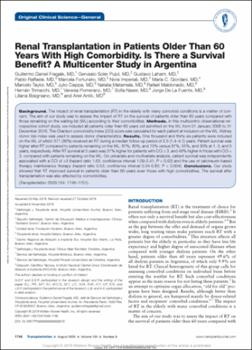| dc.description.abstract | Abstract
Background: The impact of renal transplantation (RT) in the elderly with many comorbid conditions is a matter of concern. The aim of our study was to assess the impact of RT on the survival of patients older than 60 years compared with those remaining on the waiting list (WL) according to their comorbidities.
Methods: In this multicentric observational retrospective cohort study, we included all patients older than 60 years old admitted on the WL from 01 January 2006 to 31 December 2016. The Charlson comorbidity index (CCI) score was calculated for each patient at inclusion on the WL. Kidney donor risk index was used to assess donor characteristics.
Results: One thousand and thirty-six patients were included on the WL of which 371 (36%) received an RT during a median follow-up period of 2.5 (1.4-4.1) years. Patient survival was higher after RT compared to patients remaining on the WL, 87%, 80%, and 72% versus 87%, 55%, and 30% at 1, 3, and 5 years, respectively. After RT survival at 5 years was 37% higher for patients with CCI ≥ 3, and 46% higher in those with CCI < 3, compared with patients remaining on the WL. On univariate and multivariate analysis, patient survival was independently associated with a CCI of ≥3 (hazard ratio 1.62; confidence interval 1.09-2.41; P < 0.02) and the use of calcineurin-based therapy maintenance therapy (hazard ratio 0.53; confidence interval 0.34-0.82; P < 0.004).
Conclusions: Our study showed that RT improved survival in patients older than 60 years even those with high comorbidities. The survival after transplantation was also affected by comorbidities. | en_US |


